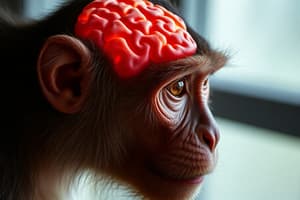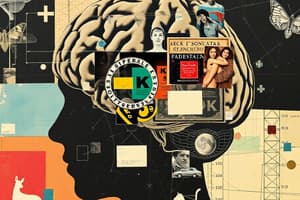Podcast
Questions and Answers
What is the primary function associated with the medial prefrontal cortex (mPFC) in the context of the default network?
What is the primary function associated with the medial prefrontal cortex (mPFC) in the context of the default network?
- Regulating emotional responses to social situations
- Evaluating self-referential information (correct)
- Processing visual and auditory inputs
- Coordinating motor responses to external stimuli
Which statement about the anterior cingulate cortex (ACC) is most accurate?
Which statement about the anterior cingulate cortex (ACC) is most accurate?
- It is mainly active during visual perception tasks.
- It helps differentiate between positive and negative self-referential outcomes. (correct)
- It is responsible for motor control and coordination.
- It is primarily involved in processing sensory stimuli.
How do patients with orbitofrontal cortex (OFC) lesions typically behave in social situations?
How do patients with orbitofrontal cortex (OFC) lesions typically behave in social situations?
- They display unrealistic positive views of themselves. (correct)
- They engage in appropriate social behaviors based on context.
- They prefer solitude over social interactions.
- They tend to be overly critical of their social performance.
In the context of self-judgment, what occurs when individuals evaluate their performance from a third-person perspective?
In the context of self-judgment, what occurs when individuals evaluate their performance from a third-person perspective?
Which hypothesis explains the increased activity of the resting state brain network while at rest?
Which hypothesis explains the increased activity of the resting state brain network while at rest?
Which describes the activation of the superior temporal sulcus (STS) during eye gaze observation tasks?
Which describes the activation of the superior temporal sulcus (STS) during eye gaze observation tasks?
What was a key finding regarding the rTPJ in individuals with ASD during mental judgment tasks?
What was a key finding regarding the rTPJ in individuals with ASD during mental judgment tasks?
What is the role of the temporo-parietal junction (TPJ) in social cognition?
What is the role of the temporo-parietal junction (TPJ) in social cognition?
What did the mirror neuron study reveal about typical children compared to ASD children?
What did the mirror neuron study reveal about typical children compared to ASD children?
How does the default network function in individuals with ASD during self-referential tasks?
How does the default network function in individuals with ASD during self-referential tasks?
What is the role of the mPFC in social interactions according to the content?
What is the role of the mPFC in social interactions according to the content?
Which brain area is notably activated when utilizing theory of mind to understand others' intentions?
Which brain area is notably activated when utilizing theory of mind to understand others' intentions?
What was the impact of lesions to the OFC in patients such as Phineas Gage?
What was the impact of lesions to the OFC in patients such as Phineas Gage?
In the context of the False Belief Task, what does a failure to understand another's perspective indicate?
In the context of the False Belief Task, what does a failure to understand another's perspective indicate?
What does the deactivation of the mPFC indicate during judgment tasks?
What does the deactivation of the mPFC indicate during judgment tasks?
What brain region is primarily associated with self-referential processing?
What brain region is primarily associated with self-referential processing?
Which of the following statements best describes the self-reference effect?
Which of the following statements best describes the self-reference effect?
What does less deactivation in the medial prefrontal cortex indicate during self-referential tasks?
What does less deactivation in the medial prefrontal cortex indicate during self-referential tasks?
What does the case of patient DB illustrate regarding self-knowledge?
What does the case of patient DB illustrate regarding self-knowledge?
The resting state network is primarily active during what kind of mental processes?
The resting state network is primarily active during what kind of mental processes?
Flashcards
Self-reference effect
Self-reference effect
The tendency to remember information better when it's related to us, because we process it in a deeper way.
Medial prefrontal cortex (mFC)
Medial prefrontal cortex (mFC)
A part of the brain that shows less activity when you're thinking about yourself. It's involved in processing information that's self-related.
Personal agency
Personal agency
The ability to have control over our own actions and movements.
Resting state network
Resting state network
Signup and view all the flashcards
Self-knowledge
Self-knowledge
Signup and view all the flashcards
Resting State Brain Network
Resting State Brain Network
Signup and view all the flashcards
Orbitofrontal Cortex (OFC)
Orbitofrontal Cortex (OFC)
Signup and view all the flashcards
Utilization Behavior
Utilization Behavior
Signup and view all the flashcards
Self-Referential Processing
Self-Referential Processing
Signup and view all the flashcards
Theory of Mind
Theory of Mind
Signup and view all the flashcards
Temporo-Parietal Junction (TPJ)
Temporo-Parietal Junction (TPJ)
Signup and view all the flashcards
Superior Temporal Sulcus (STS)
Superior Temporal Sulcus (STS)
Signup and view all the flashcards
Congruent Eye Gaze
Congruent Eye Gaze
Signup and view all the flashcards
Incongruent Eye Gaze
Incongruent Eye Gaze
Signup and view all the flashcards
Theory of mind (ToM)
Theory of mind (ToM)
Signup and view all the flashcards
Sally-Anne False Belief Task
Sally-Anne False Belief Task
Signup and view all the flashcards
False photograph experiment
False photograph experiment
Signup and view all the flashcards
Study Notes
Social Cognition
- Social cognition involves processing information about oneself and others.
- This process is not uniform: individual and cultural differences affect it.
- Emotional factors play a significant role in social cognition.
Anatomical Structures of Social Cognition
- Prefrontal Cortex (PFC):
- Dorsolateral prefrontal cortex (dIPFC)
- Ventrolateral prefrontal cortex (vIPFC)
- Orbitofrontal cortex (OFC):
- Ventromedial prefrontal cortex (vmPFC)
- Posterior cingulate cortex (PCC)
- Anterior cingulate cortex (ACC)
- Automatic Nervous System (ANS)
- Hypothalamic-Pituitary-Adrenal (HPA) axis
- Superior Temporal Sulcus (STS)
- Fusiform Face Area (FFA)
- Temporoparietal Junction (TPJ)
- Medial Parietal Cortex
Social Isolation
- Socially isolating rats exhibits changes in PFC function, synaptic plasticity, and increased aggression in adulthood.
- Lack of social play in rats during a specific developmental period (21-42 days postnatal) leads to impaired decision-making abilities in adulthood.
Self-Reference Effect
- Remembering information related to oneself is more efficient than remembering information about others.
- Medial frontal cortex is highly involved in processing self-referential information.
Theory of Mind
- The ability to understand the mental states of others.
- This process involves the TPJ (temporal parietal junction).
- Failure to engage in this task is associated with difficulties in social context.
Judging the Self
- Positive self-judgments involve less activity in the ventral anterior cingulate cortex (VACC).
- Negative self-judgments activate the VACC
- VACC impairment is found in depressed patients, suggesting a link between emotional regulation and this brain region.
OFC (Orbitofrontal Cortex)
- The OFC is involved in social emotion and knowledge.
- Damage to the OFC can result in "utilization behavior" (inappropriate social behaviours).
- Patients struggle to judge the behaviours of others, struggle with theory of mind tasks, and struggle with self-perception.
Prefrontal and OFC Damage
- Damage to these areas impacts the ability to plan for the future, control impulses, and display pro-social behaviours.
Perception of Others
- The mPFC (medial prefrontal cortex) shows greater deactivation when thinking about others than when making inferences about oneself.
- There are different brain areas involved in judging self and judging others, leading to distinct activation patterns.
Empathy and Pain of Others
- Brain activity related to perceiving one's own pain and another's pain is often similar.
- A shared pain and empathy network exist, suggesting an overlap in how the brain processes both situations.
- Empathy is linked to the activation of mirror neurons in the brain and mirror neuron activity correlates with experience of emotions.
- When exposed to expressions of pain from others or when empathizing, individuals often activate similar regions as when experiencing personal pain.
Empathy and Perceived Pain
- The anterior insula and the nucleus accumbens are associated with experiencing empathy and the desire for revenge.
Default Mode Network
- The default mode network plays a significant role in self-referential processing and social cognition.
- Orbitofrontal cortex is involved in the default mode network and is essential for behaving within social norms.
Studying That Suits You
Use AI to generate personalized quizzes and flashcards to suit your learning preferences.




